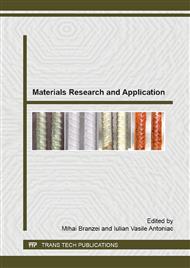[1]
R.R. Wang, A. Fenton, Titanium for prosthodontic applications: a review of the literature, Quintessence Int. 27 (6) (1996), 401-408.
Google Scholar
[2]
N. Suansuwan, M.V. Swain, Adhesion of porcelain to titanium and titanium alloy, J. Dent. 31 (7) (2003), 509 -518.
DOI: 10.1016/s0300-5712(03)00071-x
Google Scholar
[3]
M. Yoda, T. Konno, Y. Takada, K. Iijima, J. Griggs, O. Okuno, Bond strength of binary titanium alloys to porcelain, Biomaterials 22 (2001), 1675-1681.
DOI: 10.1016/s0142-9612(00)00329-x
Google Scholar
[4]
H.J. Rack, J.I. Qazi, Titanium alloys for biomedical applications. Mater Sci Eng C Mater Biol Appl 26 (2006), 1269–1277.
Google Scholar
[5]
C. Mehl, B. Lang, H. Kappert, M. Kern, Microstructure analysis of dental castings used in fixed dental prostheses: A simple method for quality control , Clinical Oral Investigations, 15 ( 2011), 383 – 391.
DOI: 10.1007/s00784-010-0394-x
Google Scholar
[6]
H. Kawahara, S. Ochi, K. Tanetani, K. Kato, M. Isogai, H. Mizuno, H. Yamamoto, A. Yamagami, Biological testing of dental materials., J. Jpn. Soc. Dent. Apparatus Mater 4 (1963), 65-75.
Google Scholar
[7]
Y. Ucar, W.A. Brantley, W.M. Johnston, M. Iijima, D.S. Han, T. Dasgupta, Microstructure, elemental composition, hardness and crystal structure study of the interface between a noble implant component and cast noble alloys , The Journal of Prosthetic Dentistry, 106(3) (2011).
DOI: 10.1016/s0022-3913(11)60116-9
Google Scholar
[8]
W.H. Guo, W.A. Brantley, W.A.T. Clark, P. Monaghan, M.J. Mills, Transmission electron microscopic investigation of a Pd-Ag-In-Sn dental alloy, Biomaterials, 24 (2003), 1705 – 1712.
DOI: 10.1016/s0142-9612(02)00564-1
Google Scholar
[9]
J. Buhagiar, H. Dong, Corrosion properties of S-phase layers formed on medical grade austenitic stainless steel , Journal of Materials Science: Materials in Medicine, 23 (2012), 271 – 281.
DOI: 10.1007/s10856-011-4516-z
Google Scholar
[10]
J.O.M. Bockris, B.E. Conway, E. Yeager, R.E. White, Electrochemical materials science: comprehensive treatise of electrochemistry, vol. 4. New York: Plenum Press; (1981).
DOI: 10.1002/bbpc.19820860822
Google Scholar
[11]
S.P. Kedici, A.A. Aksut, M.A. Kilicarslan, G. Bayramoglu, K. Gokdemir, Corrosion behaviour of dental metals and alloys in different media. J Oral Rehabil 25 (1998), 800–808.
DOI: 10.1046/j.1365-2842.1998.00305.x
Google Scholar
[12]
J.C. Wataha, Biocompatibility of dental casting alloys: a review. J Prosthet Dent 83 (2000), 223–234.
Google Scholar
[13]
D. Upadhyay, M.A. Panchal, R.S. Dubey, V.K. Srivastava, Corrosion of alloys used in dentistry: a review. Materials Science and Engineering: A, Vol. 432, Iss. 1, (2006), 1-11.
DOI: 10.1016/j.msea.2006.05.003
Google Scholar
[14]
C. Manaranche, H. Hornberger, A proposal for the classification of dental alloys according to their resistance to corrosion. Dental materials, 23(11), (2007), 1428-1437.
DOI: 10.1016/j.dental.2006.11.030
Google Scholar
[15]
G. Manivasagam, D. Dhinasekaran, A. Rajamanickam, Biomedical Implants: Corrosion and its Prevention-A Review, Recent Patents on Corrosion Science, 2 (2010) (1877-6108/10 2010 Bentham Open), 40-54.
DOI: 10.2174/1877610801002010040
Google Scholar
[16]
H.R.A. Bidhendi, M. Pouranvari, Corrosion study of metallic biomaterials in simulated body fluid. Metallurgical & Materials Engineering, Vol. 17, Iss. 1 (2011)., 13-22.
DOI: 10.30544/384
Google Scholar
[17]
E.P. Ivanova, B. Kateryna, J.C. Russell, New functional biomaterials for medicine and healthcare, Vol. 67. Woodhead Publishing, Chapter 5–Metallic biomaterials: types and advanced applications (2014), 121–147, (doi: 10. 1533/9781782422662. 121).
DOI: 10.1533/9781782422662.121
Google Scholar
[18]
S.W. Dean Jr., W.D. France Jr.,. S.J. Ketcham, Electrochemical Methods, Handbook on Corrosion Testing and Evaluation, W. H. Ailor (ed), , J. Wiley, New York, New York, 1971, 171-215.
Google Scholar
[19]
D.J.L. Treacy, R.M. German, Chemical stability of gold dental alloys, Gold Bulletin, Vol. 17, Issue 2 (1984), 46-54.
DOI: 10.1007/bf03214698
Google Scholar
[20]
J. Buhagiar, A. Spiteri, M. Sacco, E. Sinagra, H. Dong, Augmentation of crevice corrosion resistance of medical grade 316LVM stainless steel by plasma carburising Corrosion Science, 59 (2012), 169–178.
DOI: 10.1016/j.corsci.2012.02.023
Google Scholar
[21]
A.C. Pârâu, S. Zamfir, R.I. Zamfir, G. Coleaşǎ, Comparative studies on the corrosion resistance of Ti6Al4V and NiCr alloys in artificial saliva, UPB Scientific Bulletin, Series B: Chemistry and Materials Science, Vol. 74, Iss. 4 (2012), 237-248.
Google Scholar
[22]
O. Addison, A.J. Davenport, R.J. Newport, S. Kalra, M. Monir, J.F.W. Mosselmans, D. Proops, R.A. Martin, Do passive' medical titanium surfaces deteriorate in service in the absence of wear, Journal of The Royal Society Interface, 7 (2012).
DOI: 10.1098/rsif.2012.0438
Google Scholar
[23]
C. Eriksson, H. Nygren, K. Ohlson, Implantation of hydrophilic and hydrophobic titanium discs in rat tibia: cellular reactions on the surfaces during the first 3 weeks in bone. Biomaterials 25 (2004), 4759–66.
DOI: 10.1016/j.biomaterials.2003.12.006
Google Scholar
[24]
B.D. Ratner, A.S. Hoffman, F. Schoen, J. Lemons, Biomaterials Science: An Introduction to Materials in Medicine, Second Edition, ed. Academic Press, (2004).
Google Scholar
[25]
L. Linder, A. Carlsson, L. Marsal, L.M. Bjursten, P.I. Branmartk, Clinical Aspects of Osseointegration in Joint Replacement, A Histological Study of Titanium Implants. Journal of Bone and Joint Surgery 70 (1988) 550–555.
DOI: 10.1302/0301-620x.70b4.3403596
Google Scholar
[26]
J.C. Souza, S.L. Barbosa, E.A. Ariza, M. Henriques, W. Teughels, P. Ponthiaux, J.P. Celis, L.A. Rocha, How do titanium and Ti6Al4V corrode in fluoridated medium as found in the oral cavity? An in vitro study, Materials Science and Engineering: C, 47(2015).
DOI: 10.1016/j.msec.2014.11.055
Google Scholar
[27]
A.S. Guilherme, G.E. Henriques, R.A. Zavanelli, M.F. Mesquita, Surface roughness and fatigue performance of commercially pure titanium and Ti-6Al-4V alloy after different polishing protocols, J Prosthet Dent., 93(4) (2005), 378-385.
DOI: 10.1016/j.prosdent.2005.01.010
Google Scholar


